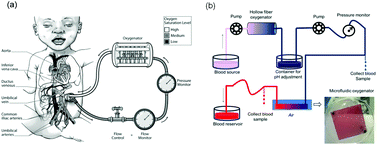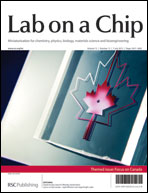Lung assist device: development of microfluidic oxygenators for preterm infants with respiratory failure†
Abstract
This paper reports the development of microfluidic oxygenator (MFO) units designed for a lung assist device (LAD) for newborn infants. This device will be connected to the umbilical vessels like the natural placenta and provide gas exchange. The extracorporeal blood flow is only driven by the pressure difference between the umbilical artery and vein without the use of external pumps. The LAD is designed for use in ambient air (∼21% of 760 mmHg). The main focus of this paper is the presentation of the development of the MFO units testing various membrane materials with human blood to enhance gas exchange and in the design of fluidic inlets to lower the pressure drop across the oxygenator. Four different membranes, including thin film PDMS, porous PDMS, and two different pore size porous polycarbonate membranes are compared in this study. Among them, the microfluidic oxygenator with porous PDMS membrane has the highest gas exchange rate of 1.46 μL min−1 cm2 for oxygen and 5.27 μL min−1 cm2 for carbon dioxide and performs better than a commercial hollow fiber-based oxygenator by 367 and 233%, respectively. A new tapered inlet configuration was designed to reduce the pressure drop across the oxygenator and showed a further 57% improvement over the traditional perpendicular inlet configuration.

- This article is part of the themed collection: Focus on Canada

 Please wait while we load your content...
Please wait while we load your content...